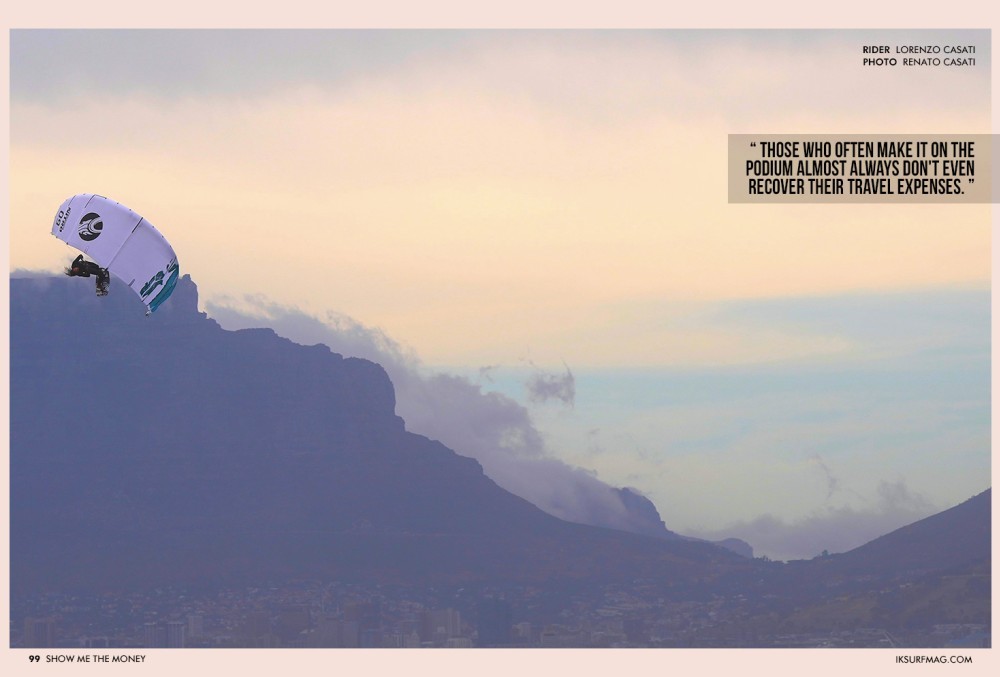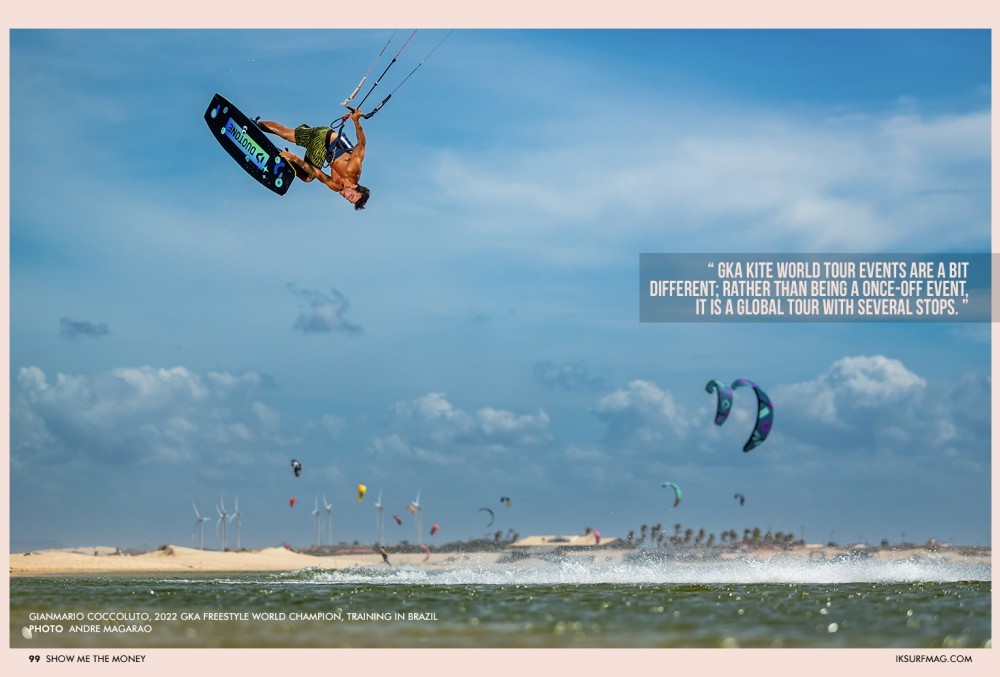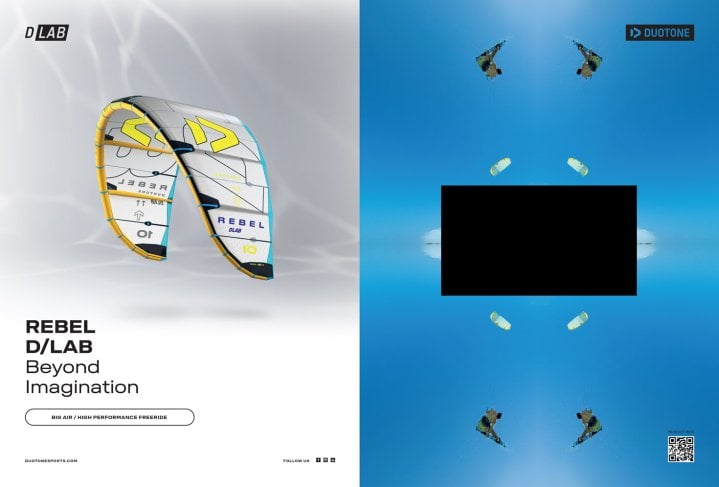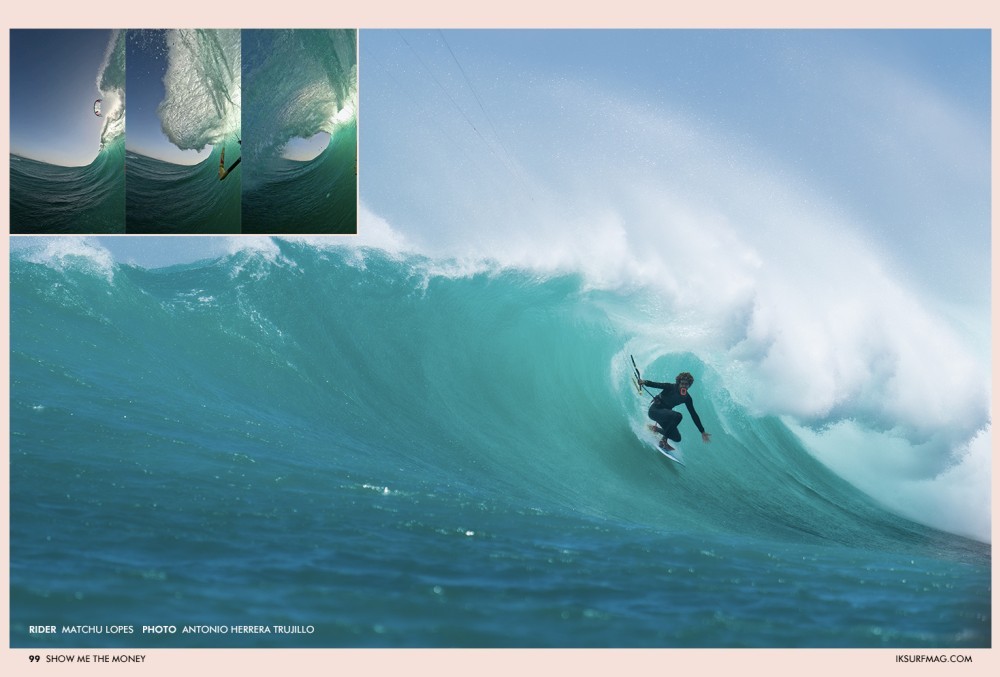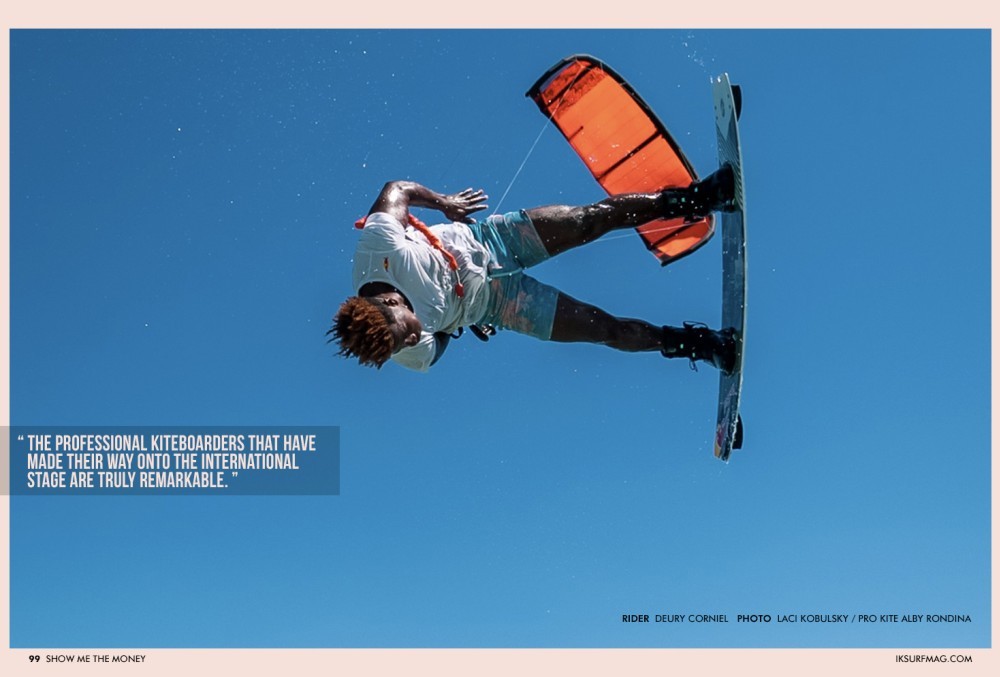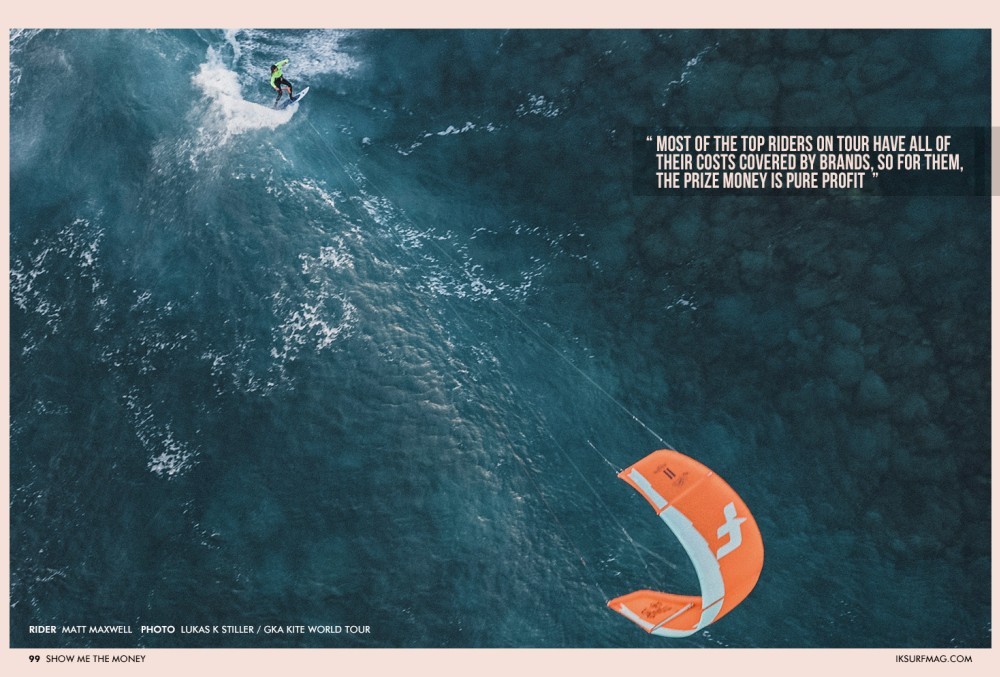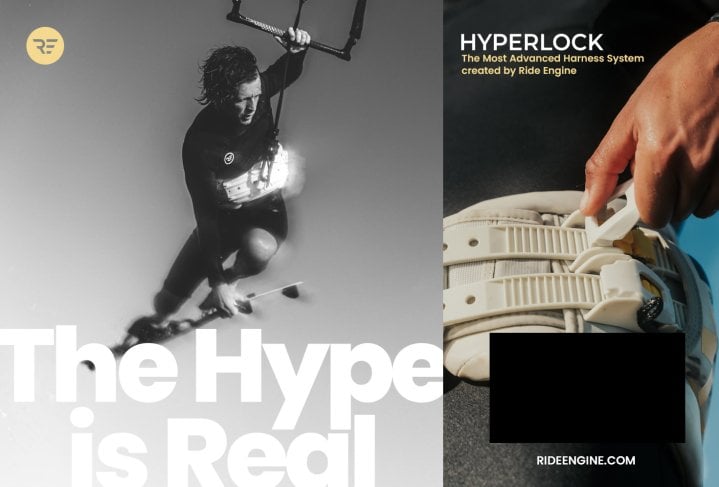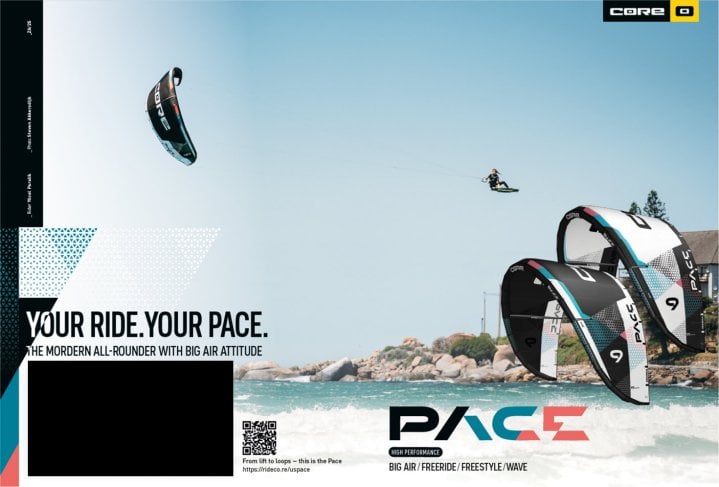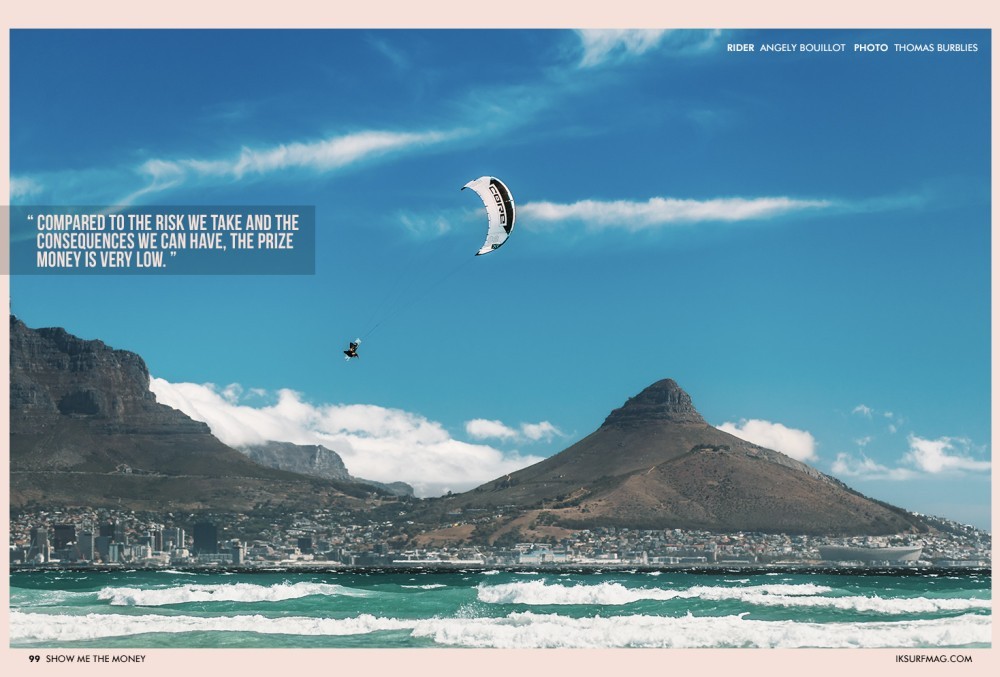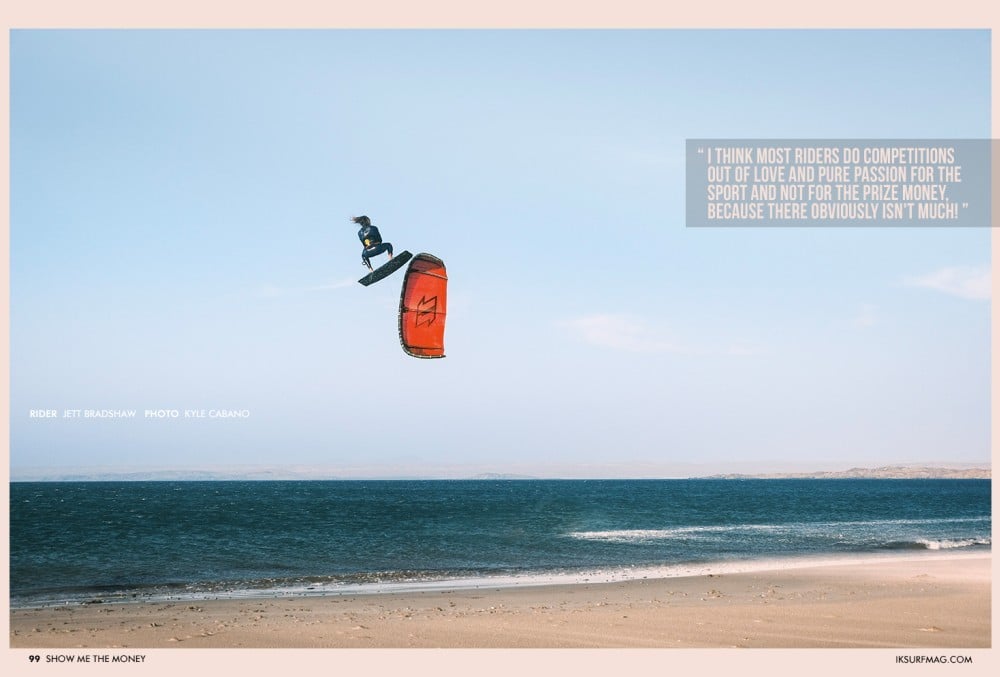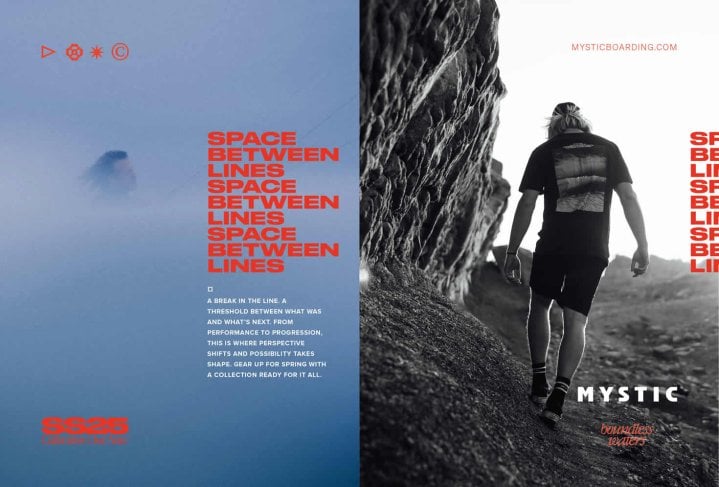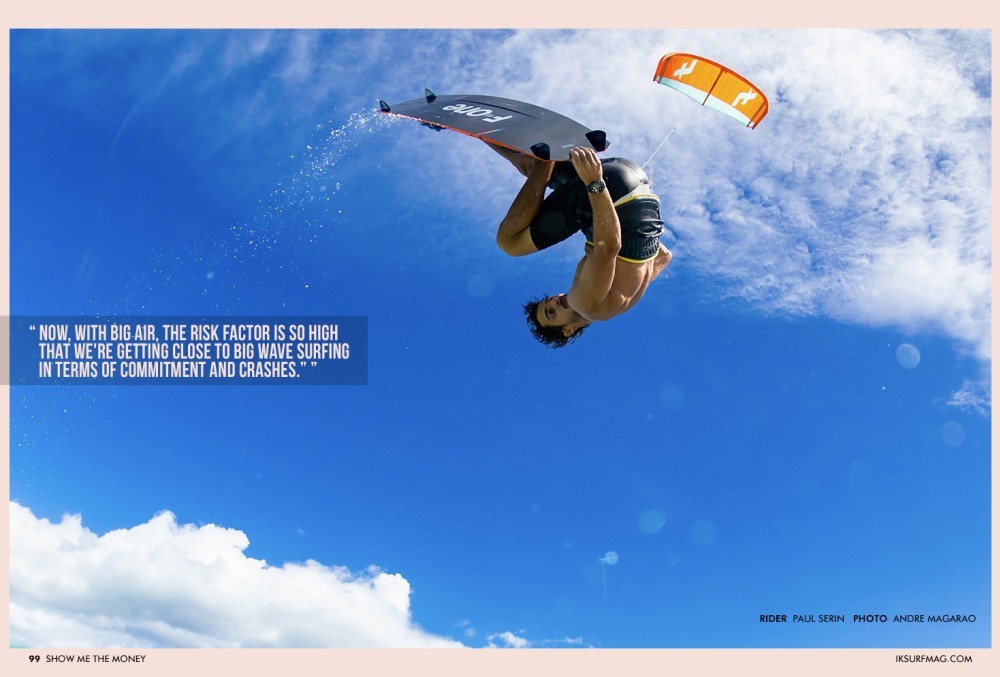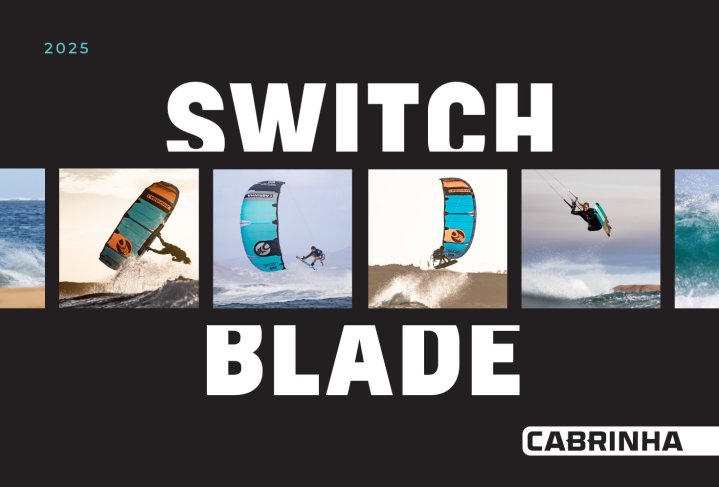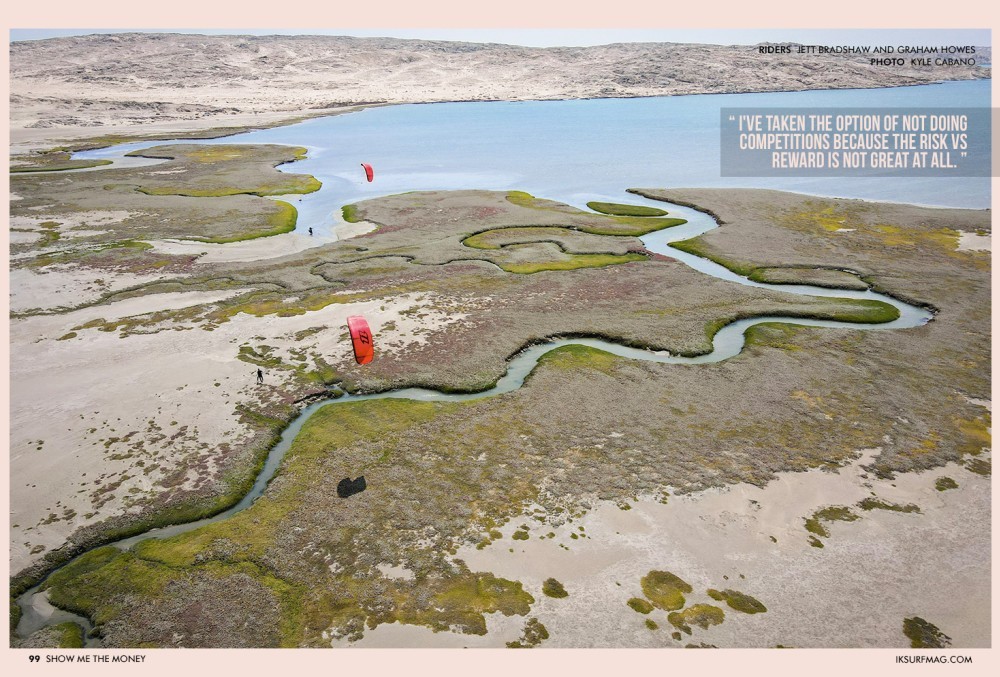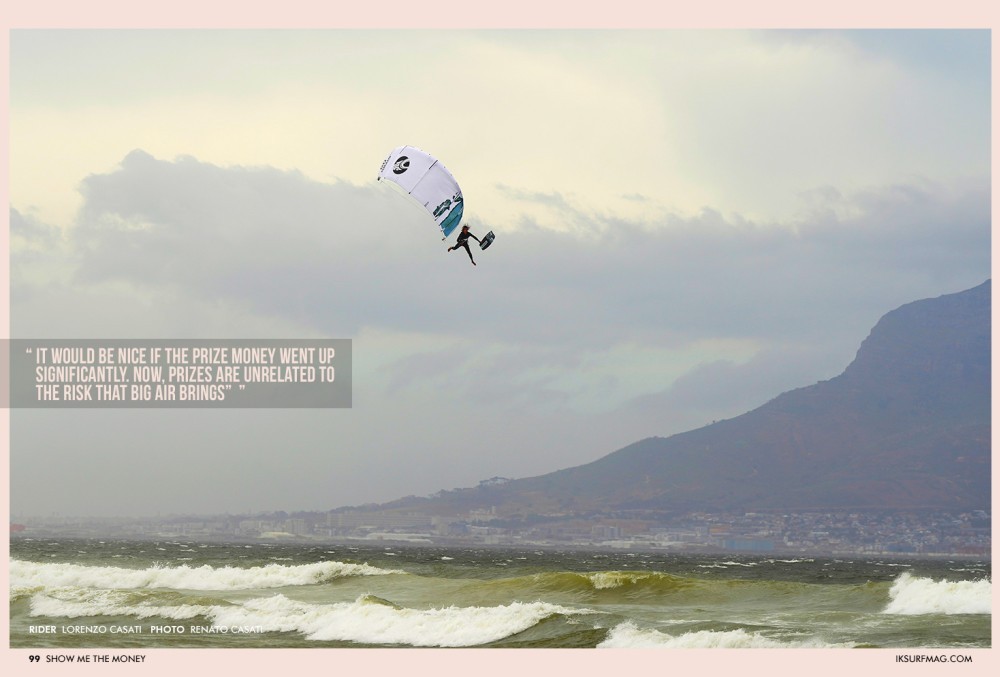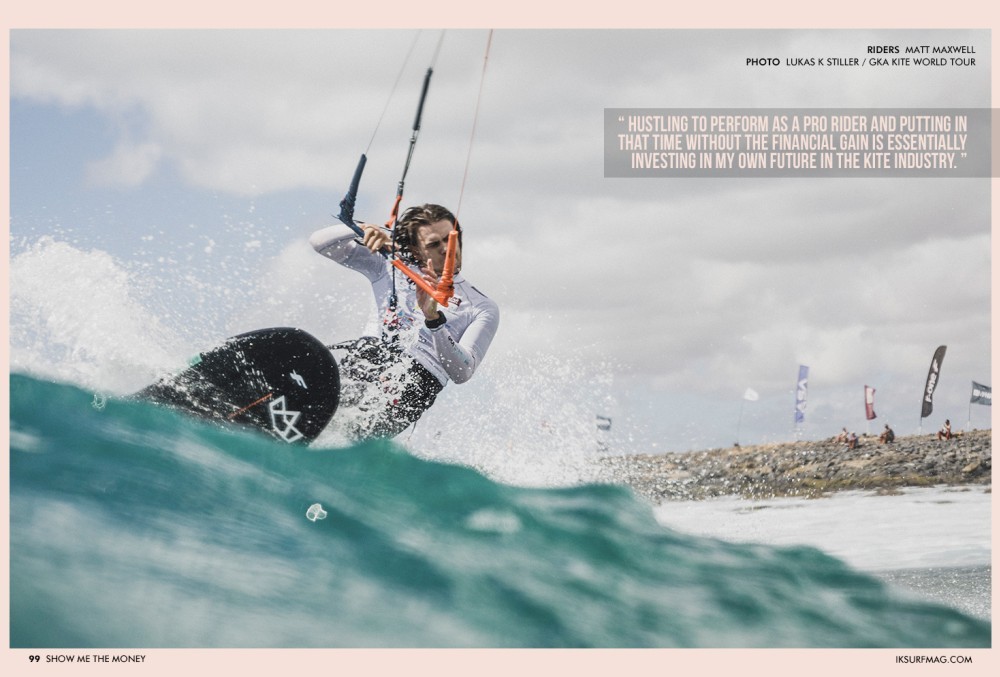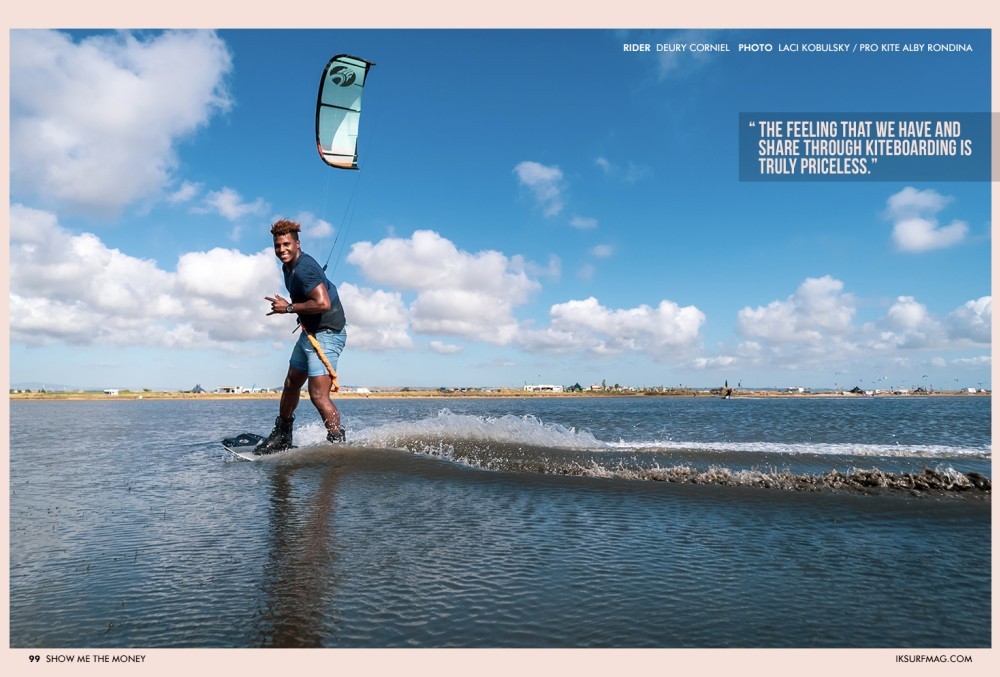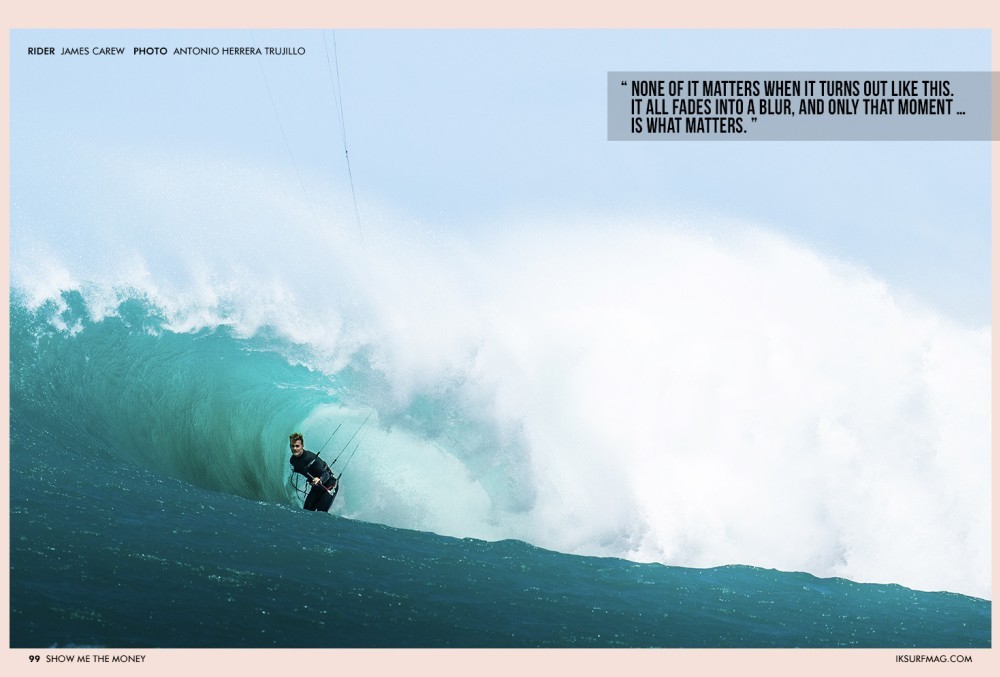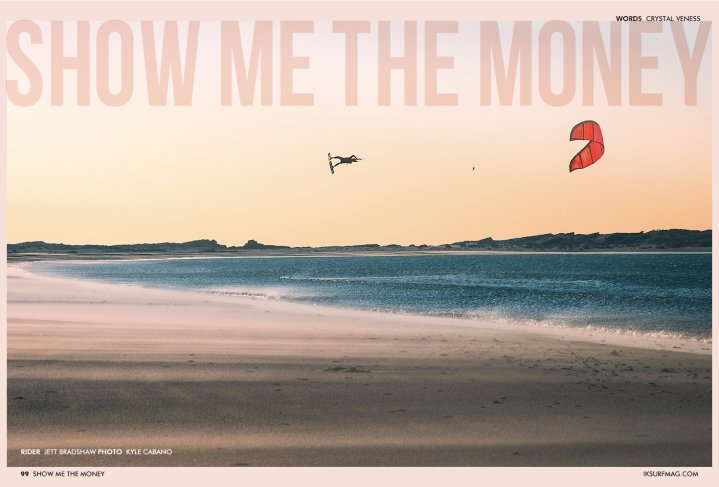
Show Me The Money
Issue 99 / Tue 6th Jun, 2023
Getting your name in the history books of kiteboarding takes some serious blood, sweat, and tears. For those professional athletes that have dedicated their careers to becoming the best in the world, is it worth it? In this article, Crystal Veness looks at the money behind competitive kiteboarding, with insights from some of the sports top riders. Read it here, exclusively in IKSURFMAG!
Kiteboarding is a sport that requires immense skill, talent, and athleticism. If you've stood on the beach at any recent kite events or been lucky enough to suffer the sandblast that is the Red Bull King of the Air, you've seen the absolute extreme of our sport. It's safe to say that the professional kiteboarders that have made their way onto the international stage are truly remarkable. These riders, some just teenagers, have pushed the boundaries of what's possible on the water and forever left their mark on the future of our sport.
Despite the popularity of kiteboarding and the impressive feats of the talented athletes that fly across our screens and sail over our beaches day in and day out, professional kiteboarders are often not compensated fairly for their talents and hard work. While professional rider contracts are not public information, it is common knowledge within the industry that there are very few rider contracts that have a base salary or living wage built into them until you reach the absolute top of the sport.
Many pro kiters are still making it work by living the ultimate hustle, creating content to earn media incentives, claiming prize money and gaining exposure by performing well in competitions, and maintaining a high level of skill and a reputation for taking direction and working well within a team to be invited on paid product shoots. Others operate camps and clinics to share their skills with their fans, start working behind the camera, which often pays more than being in front of it, seek out external sponsors or partnerships, or develop their knowledge and education so that they can earn a coveted career role within the industry, such as an R&D or marketing position.
While contract specifics and athlete salaries are not public information, the amount of prize money that riders receive usually is, and that's what I'd really like to address in this article. Why? Because after the high of watching a major global kite competition, watching the big cheques with their little numbers walk out onto the podium is, to put it simply, a bummer.
Before I go further, I do want to recognise that the lack of prize money in local and national events and grass-roots competition series that are working their way off the ground is acceptable. The efforts of everyone, primarily volunteers, involved in pulling these labour-intensive events off are seriously impressive. It would be impossible without a passionate community and, of course, some assistance from the local brand reps, kite shops, and small businesses who come to the table with their time, experience, products, and, sometimes, cash. While events in this category are not financially rewarding for anyone involved, organisers or athletes, they are an excellent way for up-and-coming riders to get competition experience and exposure and a reason for young riders to invest time in training to prepare for the global stage. Without conquering the local and national competition circuits, levelling up to the big leagues is impossible for promising young riders.
Back to the nitty-gritty, though. How much are these international competitions paying out? The Triple S Invitational event in Cape Hatteras finished off its 14-year run in 2019 with a 1st place prize of USD $11,000 (with equal prize money for men and women!) out of a total prize purse of USD $70,000 - not too shabby considering the first year of the event offered only street cred as a reward. At the time, that 1st place cheque was close to the highest possible amount an athlete could earn in a single kite competition. Unfortunately, it still is.
KOTA is, of course, the gold standard of big air, or appears to be. While the Red Bull organisation doesn't publicly share the actual numbers or hand out those giant cheques, there are plenty of rumours and estimates swirling around. An insider told us that 1st place at the previous event took home €10.000. However, unlike some of the other events that pay only the podium places, athletes all the way down the list for KOTA take something home, even if it's just a bit. The number seems a bit low, though, doesn't it? It is, after all, the most extreme event on the calendar and the longest-running big air event in the sport, drawing the biggest audience. Not to mention, it has one of the most well-known brand names on the planet attached to it.
GKA Kite World Tour events are a bit different; rather than being a once-off event, it is a global tour with several stops. However, it still features the top athletes in the world, and riders have to work their butts off to get their places on the podium. A GKA event has a total prize purse of between €25.000 and €40.000, depending on the stop. At each GKA event, the 1st prize winner takes home approximately €3.000. If you were to ride every wave event in the year, flying between Cabo Verde, Brazil, Germany, Morocco, and back to Brazil, and win every single event, you'd have €15.000 to show for it. I wonder how much those flights cost?
Matt Maxwell, a South African national and competitor on the GKA Kite Surf World Tour, shares his point of view on the prize purse, "That, to me, sounds pretty good, especially when you convert it to the South African Rand! But, when you consider the fact that every single trip to go and compete, for me, costs at least €2.500-€3.000 to get there and cover accommodation for a few weeks, it's not great. Considering the maximum money you can possibly win only covers those costs and doesn't make you any profit, it's not an ideal way to earn money."
Paul Serin is currently serving as a judge on the GKA Kite World Tour but has, in the past, been a competitor. I was excited to get his perspective as someone able to speak from both sides of the table. Paul says, "Kiting is a high-risk sport, and the ratio between cost and benefit is, most of the time, not really worth it. Now, with big air, the risk factor is so high that we're getting close to big wave surfing in terms of commitment and crashes."
Things haven't improved too much over the past decade of competitive kiteboarding, unfortunately, with the competitive scene taking as many steps forward as it has back. Paul goes on to highlight how the prize money has changed over the past 10 years, saying, "When I started competing back in 2012, freestyle was the main discipline, and the prize money was around €6.000 for first place at a PKRA freestyle event, which I thought was pretty fair. Then, the tour had some issues and started from zero with the GKA in 2018. When you need to rebuild something where all the trust has been lost, it's tough."
The demise of the PKRA resulted in a major hit to the prize money, but as Paul Serin said, "All the riders understood that, in the early GKA events, the prize money was 3-4 times less than what it used to be. The whole community of competitive kiters are aware that if they don't push for events, even if they are small, it will be the end of the series." He continues on the positive impact of the world tour, saying, "The GKA is doing a great job today by pushing all the disciplines and keeping the sport thriving on a competitive side."
Many event series, including the GKA and BAKL, have made the commitment to equal prize money between men and women. Angely Buillot, undoubtedly the biggest name in women's big air and an athlete that has almost single-handedly sent the level of women's big air into the stratosphere, shares her thoughts on the disparity in prize money, "For a long time, women had lower prize money, but the risks are the same. I never really fought for that; it's not what I'm interested in. Inequalities reign in this world, and there are causes for me that are much more important than having the same prize money as men. I didn't really pay attention over time, but to my great surprise, at the last Lords of Tram competition, we got the same prize! Well, bravo, guys! You took your time, anyway."
Sensi Graves, an American athlete who hustled her way to the top and became a frequent podium-holder in the park riding scene, shares her take, adding, "Competitions rarely provide enough money to cover costs to attend events that inevitably happen on all corners of the planet. To even achieve that necessitates getting on the podium. While competing, I relied on sponsor support to travel to competitions, and whatever I won at the competition was just a bonus. I believe this is why we don't see as many women competing in kiteboarding - with fewer sponsors supporting the route to making a name for yourself, it takes a long time."
Whether it's big air, freestyle, or wave riding, the sentiment is shared across the board. Lorenzo Casati, current King of the Air who will be defending his title later this year, commented, "Most of the riders have no income from competitions, and even those who often make it on the podium almost always don't even recover their travel expenses. You could do many events to get the experiences to emerge on top, but if each event is a considerable cost that you'll never recover, it's not easy to stand out, especially without a strong sponsor supporting you deeply."
Sponsors and kite brands are, it seems, the driving force to getting the top riders to competitions. It's clear that, based on the prize money alone, it would be impossible for riders that weren't financially independent to even participate. Matt Maxwell offers some excellent insight into how it works behind the scenes, sharing, "Most of the top riders on tour have all of their costs covered by brands, so for them, the prize money is pure profit, which makes it pretty decent. I've been fortunate to have F-ONE support me in attending events that match my discipline of wave riding and strapless freestyle."
As someone that has been in the money with the GKA over the past season, Matt says, "If I get 5th place or above, I get prize money, which is about €1.000 in 5th place - pretty decent, I'd say. However, a debate we've been having is, should riders that are not even on the podium be getting prize money at all? Or, should they instead be giving the winners on the podium more?" He continues, "It's just not viable to travel and compete unless your sponsors are paying for it. That said, I think one of the biggest problems with the tour at the moment is the spots we're going to. I think it would bring much more exposure to wave riding if they could send us to world-class spots, but we always end up going to spots where the local organisers put up the money, even if they're not suited to our discipline."
It sounds like a catch-22; do you go to the spots where there's the potential for more prize money or the spots that offer the best possible conditions for your sport? In a less-than-ideal spot, the conditions aren't great, but the purse is larger. In the perfect spot, the purse might not even exist, but the potential for world-class competition is alluring. Which one is better for the sport and/or the athletes?
Jett Bradshaw has made a name for himself in the kiteboarding world but chose to avoid the competition route in his career. He speaks frankly, saying, "We go out there and put our bodies on the line mentally and physically. It's crazy to go out at a big air competition, in 45 knots and super dangerous conditions - and the prize money can't even cover a plane ticket to the competition. So, I do think that riders get totally underpaid in competitions, and I don't think it's fair that the riders put themselves and their bodies on the line for the small amount that they can potentially earn."
Lorenzo Casati thinks there's room for improvement too, adding, "It would be nice if the prize money went up significantly. Now, prizes are unrelated to the risk that big air brings as an extreme and spectacular discipline. The hope is that kitesurfing will involve more and more important sponsors, which will bring higher budgets and bring us closer to the numbers in the world of surfing."
As the best big air rider in the world at the moment, Lorenzo is, if the numbers are correct, earning what the 33rd best surfer in the world is earning at a single event in the WSL Championship Tour. When you put it that way, it seems almost okay, given that the reach for kiteboarding is still much smaller than surfing.. But, Lorenzo has one shot at King of the Air to claim his piece of the pie, and the risk of injury is significantly higher than in surfing. In the WSL, there are 10 events in the WSL Championship Tour, so coming in 33rd in each of them would net you about $100,000 for the year. If you came in 1st place in each of those WSL events, that's about $800,000 for the year. Compared to the GKA Freestyle World Tour, where winning all 5 events in a calendar year will net you between €15.000-€20.000, the income potential, compared to the cost of travel, is somewhat laughable.
So, how can we fix the compensation issue in kiteboarding and attract more money to the sport, and whose responsibility is it? The addition of major sponsors like Qatar Airways and Porsche would seem like a solution, but recent events show that it has not resulted in noticeable increases in prize purses. If you ask me, kiters risking it all should have more money on the table.
Whose responsibility is it to compensate these athletes fairly? Some may suggest that the brands get more involved. But, brands are already supporting the athletes by sending them to events and some offering contract bonuses for strong performance. Kite brands are much smaller than airlines, finance companies, energy drink companies, or car brands, and it's unreasonable to expect much more from them. The brands are too busy and invested in creating and building the foundation of the sport to be doing more than they already are in competitions. So, where is the money going to come from? Is it coming at all?
I often wonder why these athletes even do it, when the same amount of effort and energy that they put towards their kiting career can be put towards literally anything else and, in almost every case, result in higher earnings and far fewer broken bones.
Paul Serin has some ideas on what motivates athletes to risk it for the very small biscuit, stating, "We all know that a career in pro kiting is short, and you have to make the most of it when you're at your top level, and your body can endure all the crashes and hard landings. In events like King of the Air, the ratio of risk factor and reward is still far from being even, and it will never be. However, the reward of being crowned King of the Air is probably the highest reward you could hope to achieve in a competitive big air career. It's our Olympic Games! Most of the riders don't push themselves for the money, but to show the world and the other riders that they're the best."
Matt Maxwell shares a few final words on his 'why', saying, "I don't see competitive kiting as a lucrative profession, but I see the kiting industry as something I'm super passionate about, and I'd like to get more involved in the industry (R&D) side of the sport. Participating in competitions and growing my name that way is an avenue to help both get the exposure I need and make the connections I need. Hustling to perform as a pro rider and putting in that time without the financial gain is essentially investing in my own future in the kite industry."
Jett Bradshaw says, "I've taken the option of not doing competitions because the risk vs reward is not great at all." But, there is an exception to every rule, and here's his, "Red Bull Megaloop Challenge is the only one where I am willing to put my body and life on the line. I don't need any prize money in that competition to do it! There's just something so special about Megaloop Challenge... I just want to go and participate in that event! I think most riders do competitions out of love and pure passion for the sport and not for the prize money, because there obviously isn't much!"
What drives Angelly Buillot to compete? "It's true that when I'm competing, it's not for the prize money, although I have the impression that it's starting to increase, don't you think? Compared to the risk we take and the consequences we can have, the prize money is very low. Fortunately, I'm not doing this for the money but to get out of my comfort zone and go beyond my limits of perseverance, determination and discipline - that's the hardest part."
Sensi speaks to the strength it takes to be a pro kiter, "Making ends meet as a professional kiteboarder requires persistence, determination, and a fair amount of hustle. It takes a certain type of human to want to make it work - but there are different markers of success beyond money. Travel, freedom, a love of the sport and progression all yield benefits that keep the athletes engaged and the sport moving forward."
James Carew and Matchu Lopes, both top performers in the GKA Kite Surf World Tour, scored world-class conditions at the last tour stop in Cabo Verde. James shares how he feels when everything lines up, saying "Travelling days, packing last minute, stressing over results and possible outcomes, bosses counting on your judgement to call it... None of it matters when it turns out like this. It all fades into a blur, and only that moment, being in the spot, two guys out, scoring, is what matters."
There's no question that the riders that grace the pages of this magazine have put their blood, sweat, and tears into reaching the highest echelons of the kiting world and taking it on their very shoulders to drive the growth of our sport. While, in my opinion, the compensation doesn't come close to matching the effort and risk that these riders put in, it's clear that there's more to it than the money.
Despite the compensation challenges, kiteboarding is a sport that sits close to all of our hearts and connects riders of all levels and disciplines better than anything else can. The thrill we experience on the water and soaring through the air, paired with the camaraderie of the kiteboarding community, is why we're all here. While I fervently hope that the number of zeros on those oversized cheques increases, I know that the feeling that we have and share through kiteboarding is truly priceless.
By Crystal Veness
Editor at IKSURFMAG, Crystal Veness hails from Canada but is based in South Africa. When she isn't busy kitesurfing or reporting on the latest industry news for the mag, she is kicking back somewhere at a windy kite beach or working on creative media projects.




